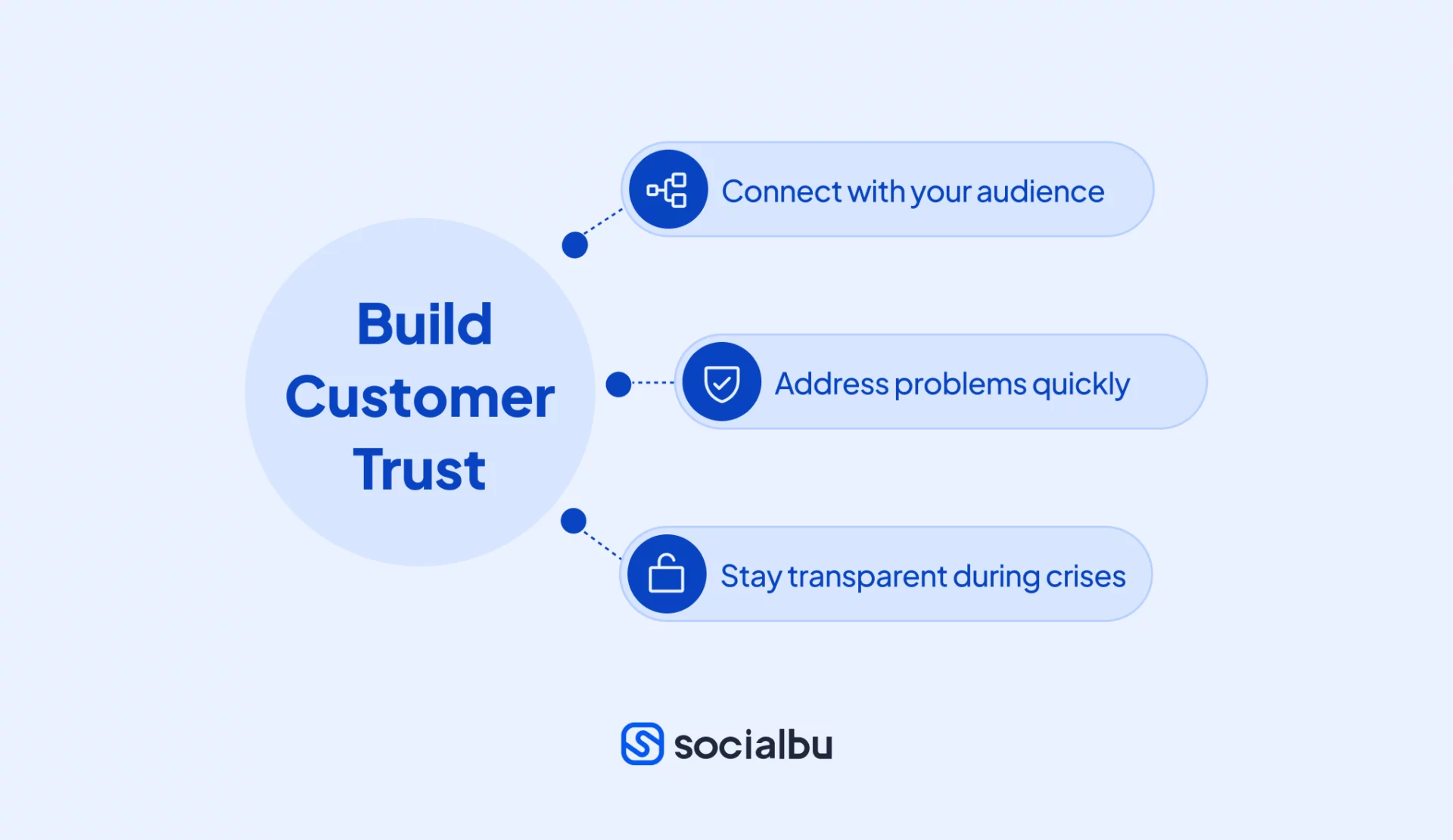Social media is a vital platform for brands to interact with their audience, maintain relationships, and stay visible. But let’s be real: it’s not always smooth sailing. Social media brand protection strategies are important because, along with incredible opportunities, social media also comes with challenges, including risks to your brand’s reputation and security.
Managing these risks involves more than simply rectifying damage; it also involves taking preventive measures to protect your business while enabling it to thrive online. To keep your brand safe and maintain trust with your customers, you need clear strategies for protecting your brand on social media.
This guide explains the common risks, how to spot them, and the steps you can take to keep your brand safe while ensuring effective ways of brand protection on social media.
Understanding the Risks to Your Brand on Social Media
Social media provides opportunities to connect with people but also exposes brands to problems that can harm their reputations. Knowing these risks is the first step toward protecting your brand.

1. Impersonation
Fraudsters may create fake accounts pretending to represent your brand. This can mislead customers, spread false information, and cause financial harm.
A 2023 report from Allure Security showed that almost half of reported fraud cases involved fake brand accounts. Taking action to protect the brand online from impersonation is important to maintaining customer trust.
2. Fake Products
Counterfeit sellers often use brand names to sell low-quality or fake goods. This damages customer trust and affects your credibility.
In 2023, scams using brand names caused an estimated $10 billion in losses worldwide. Learning how to protect your brand from counterfeiting is key to preventing such scams.
3. Bad Publicity
Negative posts by unhappy customers or malicious groups can go viral quickly, harming your brand’s image. Brands can experience a sharp decline in sales after making a mistake about social media campaigns that upset customers and target their morale.
4. Account Hacking
Weak security can let hackers take over your accounts, steal sensitive information, or post harmful messages. As brands use social media more for customer service, attackers exploit this by creating fake accounts to scam users.
Examples of Risks
Real-world examples highlight how quickly things can go wrong for brands on social media. Let’s look at some cases that emphasize the importance of being prepared.
1. Revolut Data Breach
On 11 September 2022, Revolut was hit by a cyberattack that exposed 0.16% (about 50,000) of its customer names and payment details. The company took too long to respond, giving scammers time to launch phishing attacks. Many customers lost trust, regulators fined Revolut, and many users switched to other services.

2. T-Mobile Data Breach
In January 2023, T-Mobile had another major data breach, exposing the personal info of 37 million accounts. This led to identity theft, fraud, and SIM-swap attacks. The ongoing security failures hurt T-Mobile’s reputation, pushing customers to competitors with better protection.

3. Royal Mail Cyberattack
On January 10, 2023, Royal Mail was hit by a ransomware attack that caused major disruptions to international deliveries. The LockBit group was behind it, and customer data was exposed. People were frustrated, especially because Royal Mail wasn’t very transparent about what was going on during the attack.

4. Binance Phishing Scams
There was a big rise in phishing attacks, with scammers creating fake Binance apps and websites to steal user credentials and money. Many people felt Binance didn’t do enough to stop these scams, which led to a lot of criticism.

Signs Your Brand Is at Risk
Recognizing the following signs early is crucial for protecting your brand online and ensuring a swift response to potential threats.
- You notice unexpected posts or activity on your official accounts.
- Customers complain about false information or bad products linked to your brand.
- You see fake accounts pretending to be your business.

Practical Steps to Protect Your Brand
Taking action to protect your brand requires staying alert, improving account security, and using helpful tools to monitor activity. These steps are central to any effective online brand protection strategies.
1. Monitor Mentions and Conversations
Keeping an eye on what people are saying about your brand can help you catch problems early.
Why This Matters?
- Spot issues like fake accounts or harmful campaigns before they get worse.
- Address customer complaints and negative reviews quickly.
- Detect fake use of your brand’s name to stop counterfeit sales.
Tools You Can Use
- SocialBu: Tracks brand mentions and messages across platforms in real-time.
- Google Alerts: Sends notifications about mentions of your brand or products.
- Brandwatch: Analyzes conversations to identify trends that may affect your brand.
Setting up notifications is a simple yet powerful brand protection strategy to stay ahead of potential issues.

2. Strengthen Your Online Security
Keeping your accounts secure protects your brand and customers from harm.
Steps You Can Take:
- Use two-factor authentication to protect your accounts.
- Create strong, unique passwords for every platform and change them regularly.
- Limit access to your accounts to trusted team members only.
Protect Domains and Accounts
Register variations of your domain name to avoid cybersquatting and claim unused social media handles to prevent misuse.
These measures are essential to protect branding and safeguard your digital presence against misuse or hacking.

3. Follow Legal Rules
Adhere to privacy and intellectual property laws to avoid legal trouble and protect your brand’s assets. These steps are crucial for social media and brand protection and for maintaining your credibility.
Privacy Laws
Ensure you follow rules like GDPR in Europe or CCPA in the USA, which cover how you handle customer data. Non-compliance can lead to fines, such as Meta’s €1.2 billion penalty in 2023.
Protect Your Intellectual Property
- Register your brand name, logo, and tagline as trademarks. This is an important part of protecting a brand and its assets.
- Use copyright takedown requests like the Digital Millenium Copyright Act (DMCA) to remove copied content from platforms.
How to Act Against Misuse
- Send a formal cease-and-desist notice to those misusing your brand.
- Report fake accounts or improper use of your brand name directly to social media platforms.
- If necessary, seek legal help to take action against serious violations.
These measures will help you implement an effective brand protection strategy and secure your business.

4. Build Customer Trust
Customers are more likely to defend your brand against risks if they trust you. By being responsive and transparent, you can strengthen this bond and ensure consistent brand reputation protection efforts.
Connect with Your Audience
Your interactions with customers should feel genuine and consistent. Using a trustworthy tone and engaging directly with your audience are key steps to protecting your brand reputation.
Address Problems Quickly
A quick response to customer complaints can prevent them from becoming larger issues.
- Act Fast: Reply to questions or concerns as soon as possible. Delays can frustrate customers and attract negative attention.
- Be Honest: If something goes wrong, admit it and explain how you plan to fix it. This can help rebuild trust and is essential for brand protection.
Stay Transparent During Crises
Open communication can help reduce damage to your reputation when something goes wrong. Transparency is essential for protecting your brand reputation during challenging times.
- Plan Ahead: Have a crisis response plan ready, including pre-written statements for different scenarios.
- Keep People Informed: Post updates on social media to let customers know what’s happening and how you’re handling the situation.
Being prepared is a key aspect of protecting your brand reputation and maintaining customer trust.

5. Create a Policy to Protect Your Brand
Having a clear policy helps you stay organized and prepared to address problems that arise on social media. A good policy sets clear rules and plans for handling threats and explains how to protect a brand. It also strengthens social media brand protection efforts.

What Makes a Strong Policy?
A strong policy is essential for protecting your brand and avoiding potential risks. Here’s a breakdown of what makes a policy effective and easy to follow.
- Clear Goals: Define what you want to achieve with your policy, such as protecting intellectual property, reducing impersonation risks, or staying legally compliant.
- List What You’re Protecting: Include everything from your logo and brand name to social media accounts, website domains, and marketing content.
- Step-by-Step Plans: Outline what actions to take when you identify a problem, such as fake accounts or negative publicity. Assign specific tasks to team members, like monitoring mentions or reporting violations.
Keep Your Policy Up to Date
Social media changes quickly, and so do the risks. By making policy updates a regular practice, you can confidently adapt to new social media challenges and maintain a secure online presence for your brand.
- Adapt to New Rules: Include changes in privacy and copyright laws.
- Use New Tools: Add new software or methods to improve your brand protection methods.
- Cover New Platforms: Include newly introduced social media platforms where your brand may have a presence.
Train Your Team
Employees are often the first line of defense. Make sure they know how to spot risks and take appropriate action.
- Teach Them to Identify Threats: Show employees how to recognize suspicious activity, fake profiles, or phishing attempts.
- Guide Them on Best Practices: Provide tips for handling sensitive information securely and reporting issues.
- Hold Regular Workshops: Keep the team informed about new risks and tools they can use to help protect the brand meaningfully.
6. Secure Your Social Media Accounts
Maintaining control over your accounts is key to keeping your brand safe. A blend of regular monitoring and strong security practices can prevent most problems. These practices are fundamental to protecting your brand online.

Prepare for Emergencies
A crisis plan helps you respond quickly and confidently when something goes wrong.
- Assign Roles: Make sure team members know who handles tasks like reporting fake accounts or responding to complaints.
- Have Templates Ready: Write responses in advance for situations like hacked accounts, false claims, or product complaints.
- Practice Your Plan: Test your crisis plan regularly to find and fix any weak spots.
Having a plan ensures your team understands how to protect your brand reputation effectively during critical situations.
Review Your Security Regularly
Regular account audits help you spot weaknesses before they lead to problems.
- Update Passwords: Use strong, unique passwords and change them regularly.
- Limit Admin Access: Only give account access to team members who need it.
- Keep Software Up to Date: Ensure all tools and apps have the latest security updates.
By implementing these simple measures, you can strengthen your brand protection strategy and keep your online presence secure.
Simple Steps for Account Safety
- Turn on two-factor authentication.
- Use a password manager to keep passwords secure.
- Monitor account activity for anything unusual.
- Back up important account data regularly.
These steps are easy ways to ensure the protection of brand and account security.
How Can Socialbu Help Protect Social Media Brand?
SocialBu is a useful tool for managing and protecting social media accounts. It helps brands monitor potential threats while streamlining daily tasks. Using this tool is an effective way of implementing social media and brand protection.

1. Tracks Mention in Real Time
SocialBu notifies you immediately when your brand is mentioned, helping you catch fake accounts or harmful comments early. This is essential for how to protect your brand on social media.
2. Alerts You to Problems
Its customizable alerts let you focus on issues that matter, such as negative reviews or unusual activity.
3. Keeps Accounts Secure
With features like controlled access, SocialBu ensures only trusted team members can post or make changes.
4. Makes Posting Easier
Plan and schedule posts securely, reducing the risk of mistakes. This is an essential step for protecting your brand online.
5. Supports Teamwork
SocialBu allows teams to collaborate efficiently while maintaining account security with features like role-based permissions, content approval workflows, and shared content calendars.
How to Get Started with SocialBu for Brand Protection
Protecting your brand on social media starts with the right tools and strategies. SocialBu offers a range of features to help you monitor activities, respond to threats, and manage your accounts securely.
1. Set Up Alerts
Configure real-time alerts for your brand name, key products, and potential threats. This ensures you stay updated on any mentions or unusual activity related to your brand.

2. Monitor Trends with Analytics
Leverage SocialBu’s analytics tools to track social media trends, measure performance, and identify potential risks before they escalate.

3. Delegate Tasks Securely
Use SocialBu’s access control features to assign roles and responsibilities to team members, ensuring that tasks are handled efficiently while maintaining account security.

4. Strengthen Your Brand Protection Strategy
Incorporating tools like SocialBu into your social media management routine enhances your online brand protection strategies. It equips you to proactively address challenges, maintain your brand’s reputation, and streamline your digital operations effectively.
Final Thoughts!
Keeping your brand safe on social media is important to maintain trust and protect your reputation. While social media offers great opportunities, it also comes with risks that need careful attention and handling.
To stay secure, it is crucial to remain alert for threats like fake accounts, counterfeit products, and negative publicity. Employing simple but effective strategies, such as monitoring mentions and improving account security, can make a significant difference.
Additionally, following privacy and intellectual property laws helps avoid legal trouble and protects your assets, so you must know why brand protection is important.
Consider using tools like SocialBu to streamline and enhance this process. These proactive measures ensure strong social media brand protection and enable you to focus on achieving long-term success.
FAQs
How can I protect my social media accounts?
Use strong passwords, enable two-factor authentication, monitor account activity, and use tools like SocialBu to track mentions and respond to risks.
How do businesses handle risks on social media?
Businesses train their employees to spot threats, secure their accounts, and create a crisis response plan. They also use tools to track activity and prevent issues before they arise.
How do I ensure privacy on social media?
Limit the personal information you share, adjust your account settings, and follow privacy laws to handle customer data responsibly.







